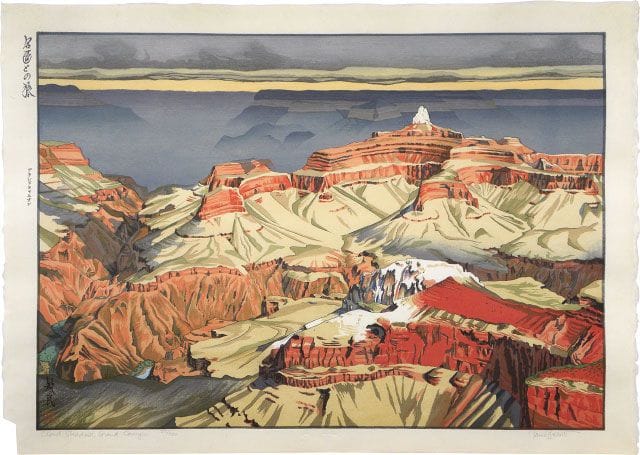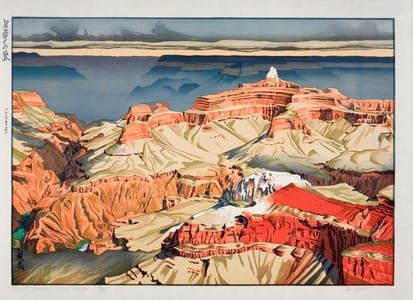

Cloud Shadows, Grand Canyon
Paul Binnie
Cloud Shadows, Grand Canyon
By now many people will have seen my new print, 'Cloud Shadows, Grand Canyon', my 100th print design and the first in a new series of landscape prints called 'Meishou to no Tabi', or Travels With The Master. But few can imagine the long and difficult process by which this print finally came into existance, taking longer than any of my other prints - in fact, two and a half years!
It all began in mid-2004 with a request from a Canadian-born dealer then living in the United States, whether I would consider travelling to Arizona to make studies for a print of the Grand Canyon. I was interested by this, as I knew the famous print by Yoshida Hiroshi of the same scene, and asked for more information, It transpired that the dealer had a client who was very keen on the Canyon, visited there often and co-incidentally had an interest in Japanese prints. Previously this same dealer had introduced me to a collector who ended up commissioning my Shiki series of bijin prints, so I was intrigued to know more, and the collector, dealer and myself discussed various ideas and possibilities via email.
It was agreed that I should go to the Canyon for about a week in September to October 2004, and the details of the trip were arranged by the dealer and collector together, and I flew out to Los Angeles, where I was met by the dealer and his wife. We spent a day or two there, where the collector joined us for a while, and all seemed well; friendly relations were formed, and everything seemed to go as expected. The plan we decided upon was to make an edition of 50 prints, and I pushed strongly for it to be in large double-Oban size - the paper of the print is 69 x 49cm, or 18 x 25 inches. The collector would put up half the money for me to do the work, and the dealer the other half, then they would sell the majority of the edition and split the proceeds.
The dealer, his wife and I drove up to Arizona, through some spectacular countryside, arriving at Grand Canyon Village at night and settling it to our lodgings near the ege of the precipice. We spent several days with varieties of weather, including rainbows, which were spectatular and quite rare, and mist, which transformed the Canyon into a ink painting of subtle shades, but the most spectacular day was one of dense cloud, broken by shafts of stong sunlight and of all the studies I made there, it was this effect that I decided to try to capture in the design I would make.
After the stay there was over, we went back to LA, then up the coastal route to San Francisco, passing towns and cities that I had known by name only, in songs and films of the 1950s and 60s. At some time on the trip, I managed to contract a form of dysentry, possible from Mexican food, which we ate a lot of, and I was ill for the next four months, on and off.
Back in London, I came up with the keyblock design, based on my sketches and studies, and I sent that to the two collaborators. It was approved, and I then began work on the keyblock. I was unaware of it at the time, but the dealer had become embroiled in a strange situation with another client, and had decided because of it to take some radical steps to change his situation. I learned this only much later, because at the time, I had made impressions of the keyblock, and bought the especially-large size wood for the rest of the colour blocks - in all, over 30 colour impressions are used in the design, printed from 14 blocks - and sent the keyblock impressions to the two sponsors of the edition for approval before beginning the carving of the colour blocks.
I was a little worried that instead of just agreeing directly, or suggesting changes in the design, the dealer suggested first that I might like to reduce the number of prints in the edition, then that I should consider becoming a 1/3 share 'owner' of the prints - by accepting less money for the work done. Finally there was a point where all discussion was severed, and I was unable to contact either the dealer or the collector and didn't know what was happening.
I had carved the keyblock and made proofs of it but had not had approval of the carving, and, in addition, I had been paid precisely nothing by the two collaborators, who had covered the travel to Grand Canyon, but had given me no payment for my work.
I waited and waited to hear from either of them, but no word came; I slowly, bit by bit, heard that the dealer had been accused of taking prints from a client's collection and selling them without permission, and had left the United States, seperated from his wife and was somewhere in Asia. Of the collector I never heard again.
So, I put all the work I had done on the Canyon print on one side, with the blank blocks still uncarved for the colours, and left the project alone for over a year and a half, as I thought there would be no way to make the print work without sponsorship.
Several of my friends, collectors and other dealers know about the project, and as I had the keyblock ready-made, suggested that I should try carving the blocks in my spare time, between other projects and that I should make an effort to produce the print as a proper finished work. They suggested offering the print to my close circle of collectors at a pre-release price, in order to raise the necessary funds to pay for the work, and a surprising number of people did indeed pay for the design in advance.
I took a while over the very detailed carving, but eventually I had the blocks ready, and then I showed a proof to those who were going to pay in advance for their prints.
In my mind, the project had developed into its current form - I wanted to link the print I was making to Yoshida Hiroshi's image of the same area, made in 1925, and to so so, I copied his katakana calligraphy for 'Grand Canyon' and made it the print title, under my own calligraphy for the series title, 'Meishou to no Tabi' or Travels with the Master, obviously in homage to Yoshida.
My growing interest in Yoshida's work has meant that I am very interested to travel to places that he depicted in his prints, and so developing the Grand Canyon print in this way seemed to be a logical step. I was very lucky in being able to ask Numabe Shinkichi, one of the master-printers at the Yoshida studio run by Hiroshi's grandson, to do the printing for me, as I was busy on other projects and anyway wanted to have this close connection with the Yoshida tradition.
Cloud Shadows is my 100th Japanese print; I will be exhibiting it in Kyoto in November, at a retrospective of my woodblock prints at Ritsumeikan University, and in his text to appear in the accompanying catalogue of my complete prints, Dr. Kendall Brown says of this design:
"Binnie is also exploring new ground in landscape. Grand Canyon (Cloud Shadows, Grand Canyon, cat. 100) is an explicit homage to Yoshida Hiroshi, who represented the same part of the canyon, and thus the print is a fitting start to the new series, Meisho to no Tabi (Travels with the Master) projected to include several landscape prints that directly address some of Hiroshi's best-known non-Japanese travel prints."
"Binnie even made a copy of the Japanese title on Hiroshi's Grand Canyon and then cut a block to reproduce it on the left margin of his own print. Moreover, like Hiroshi, Binnie uses pencil to write the print's title in English and to sign the print. In the final act of homage, Grand Canyon was printed in the Yoshida studio in an attempt to reproduce something of the "soft feel" of Hiroshi's work. Despite these acts connecting the print with Yoshida's image, Binnie worked from nature rather than from Hiroshi's print. As a result his print is, paradoxically, both entirely individual and a variation on an earlier model."
Of course only time will tell if collectors and print-lovers take my image to their hearts in the way that they have with Yoshida's prints, but I hope that my print will have its own personality and be appreciated as a sincere compliment to an artist of the past whom I admire, as well as being an expression of my own style of woodblock printmaking at the beginning of the current millenium.
(https://www.artelino.com/articles/paul-binnie-grand-canyon.asp)
Uploaded on Oct 15, 2017 by Suzan Hamer
Paul Binnie
artistArthur
coming soon

